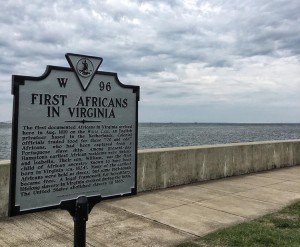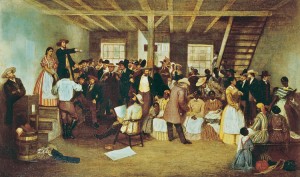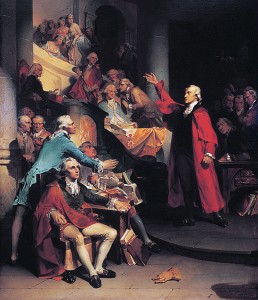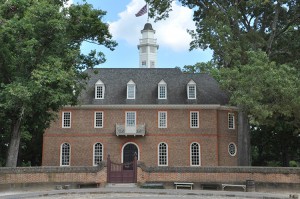No Point of Comfort
Friday, August 23rd, 2019August 23, 2019
This weekend, August 23 to 25, a somber anniversary is taking place at the Chesapeake Bay city of Hampton, Virginia. It was there, at the town once known as Point Comfort, that African slaves were first brought to England’s American colonies in August 1619. Those first slaves, captured from Portuguese slave traders, were brought to Virginia 400 years ago in the English ship White Lion. Colonial officials traded food and supplies for the “20 and odd” Africans, beginning an ugly legacy of slavery. Slavery did not end in the United States until 1865, and its effects are felt to this day.

A historical marker details the arrival of the first enslaved Africans in English North America at Point Comfort, Virginia, in August 1619. Credit: National Park Service
Commemorative events in Hampton begin today with a ceremony at the Tucker Family Cemetery, where William Tucker, the first child born (in 1624) of those first slaves, is buried. William was the son of Anthony and Isabella, who, like their fellow captives, had been brought from the Kingdom of Ndongo in what is now the southwest African nation of Angola. Tomorrow, a new Commemoration and Visitor Center telling the story of those first slaves will open at Fort Monroe, the historic army fort in Hampton that is now a national monument. There will also be Black Heritage Tours, an educational African Landing Day Program, and a Commemoration Concert at the Hampton Coliseum. Sunday, a gospel music festival will highlight a “Day of Healing,” and the ceremonies will end with the release of butterflies and a nationwide ringing of bells. In addition, the Hampton History Museum is hosting events, and its traveling exhibit “1619: Arrival of the First Africans” is making its way around churches, community groups, libraries, and schools in Virginia.

Slaves were sold at public auctions in the southern United States. Pictures of blacks being sold like merchandise stirred much resentment in the North against slavery. Credit: Detail of The Slave Auction (1862), an oil painting on canvas by Eyre Crowe; Kennedy Galleries, Inc., New York City
That first group of captive Africans in Virginia were classed along with indentured servants, because the colony did not yet have rules regarding slavery. Most indentured servants had a contract to work without wages for a master for four to seven years, after which they became free. Blacks brought in as slaves, however, had no right to eventual freedom, and they were sold at auction. Some Africans did gain their freedom, however, settling in the colonies and buying property. But racial prejudice among white colonists forced most free blacks to remain in the lowest levels of colonial society.
The slave population in America increased rapidly during the 1700′s as newly established colonies in the South created a great demand for plantation workers. By 1750, about 200,000 slaves lived mostly in the southern American colonies. The American Revolution (1775-1783) led to the birth of the United States, but all Americans were not yet considered “created equal.” By the early 1800′s, most Northern states had taken steps to end slavery, but more than 700,000 slaves lived in the South, and the numbers continued to increase. By 1860, the South held some 4 million slaves.
Many white Americans grew to feel that slavery was evil and violated the ideals of democracy. Such ideas were particularly widespread in the North, where slavery was less common. However, plantation owners and other supporters of slavery regarded it as natural to the Southern way of life. The North and the South thereby became increasingly divided over slavery. Eventually, the South rebelled against the North, starting the American Civil War (1861-1865). In 1863, President Abraham Lincoln’s Emancipation Proclamation freed the slaves in the rebellious Southern states, and, in December 1865—after the South had surrendered—the 13th Amendment to the Constitution of the United States officially ended slavery throughout the nation.
Racial prejudice against African Americans did not end there, however, and the decades after the Civil War were a constant struggle for equality. It was not until the civil rights movement of the 1950′s and 1960′s that acts, amendments, and laws formally banned racial discrimination. Racial prejudice persists in much of America, however, and the struggle for fair treatment continues.




